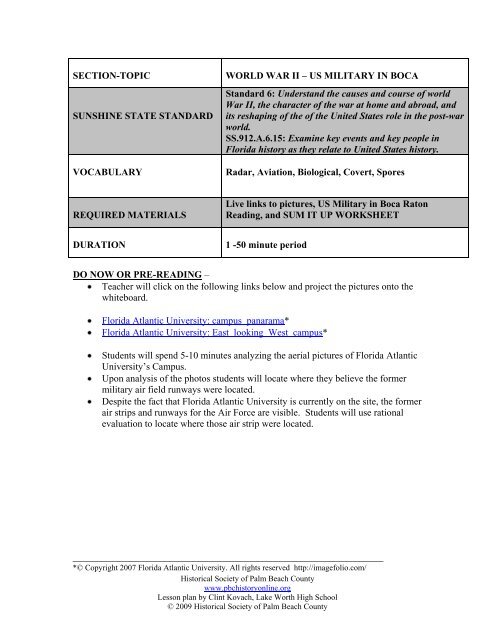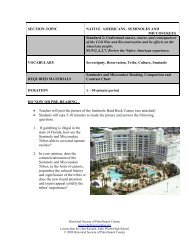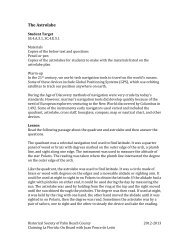US Military in Boca - Palm Beach County History On-Line
US Military in Boca - Palm Beach County History On-Line
US Military in Boca - Palm Beach County History On-Line
You also want an ePaper? Increase the reach of your titles
YUMPU automatically turns print PDFs into web optimized ePapers that Google loves.
SECTION-TOPIC<br />
SUNSHINE STATE STANDARD<br />
VOCABULARY<br />
WORLD WAR II – <strong>US</strong> MILITARY IN BOCA<br />
Standard 6: Understand the causes and course of world<br />
War II, the character of the war at home and abroad, and<br />
its reshap<strong>in</strong>g of the of the United States role <strong>in</strong> the post-war<br />
world.<br />
SS.912.A.6.15: Exam<strong>in</strong>e key events and key people <strong>in</strong><br />
Florida history as they relate to United States history.<br />
Radar, Aviation, Biological, Covert, Spores<br />
REQUIRED MATERIALS<br />
Live l<strong>in</strong>ks to pictures, <strong>US</strong> <strong>Military</strong> <strong>in</strong> <strong>Boca</strong> Raton<br />
Read<strong>in</strong>g, and SUM IT UP WORKSHEET<br />
DURATION<br />
1 -50 m<strong>in</strong>ute period<br />
DO NOW OR PRE-READING –<br />
Teacher will click on the follow<strong>in</strong>g l<strong>in</strong>ks below and project the pictures onto the<br />
whiteboard.<br />
Florida Atlantic University: campus_panarama*<br />
Florida Atlantic University: East_look<strong>in</strong>g_West_campus*<br />
Students will spend 5-10 m<strong>in</strong>utes analyz<strong>in</strong>g the aerial pictures of Florida Atlantic<br />
University’s Campus.<br />
Upon analysis of the photos students will locate where they believe the former<br />
military air field runways were located.<br />
Despite the fact that Florida Atlantic University is currently on the site, the former<br />
air strips and runways for the Air Force are visible. Students will use rational<br />
evaluation to locate where those air strip were located.<br />
________________________________________________________________<br />
*© Copyright 2007 Florida Atlantic University. All rights reserved .http://imagefolio.com/<br />
Historical Society of <strong>Palm</strong> <strong>Beach</strong> <strong>County</strong><br />
www.pbchistoryonl<strong>in</strong>e.org<br />
Lesson plan by Cl<strong>in</strong>t Kovach, Lake Worth High School<br />
© 2009 Historical Society of <strong>Palm</strong> <strong>Beach</strong> <strong>County</strong>
LESSON –<br />
Teacher will make copies of or project the follow<strong>in</strong>g read<strong>in</strong>g on the whiteboard,<br />
<strong>US</strong> <strong>Military</strong> <strong>in</strong> <strong>Boca</strong> Raton.<br />
Students will read the article and complete the SUM IT UP WORKSHEET (see<br />
attached)<br />
For each of the 8 subsections listed the student will write 1 sentence <strong>in</strong> the<br />
correspond<strong>in</strong>g box to summarize what they have read.<br />
o <strong>US</strong> <strong>Military</strong> <strong>in</strong> <strong>Boca</strong><br />
o Development of the Land<br />
o <strong>Boca</strong> Airfield and Air Corps<br />
o <strong>Boca</strong> Raton Society<br />
o Post War <strong>Military</strong> Secrets<br />
o Biological Weapon Development<br />
o Biological Weapon Use<br />
o End of Secret Weapon Development<br />
U.S. <strong>Military</strong> <strong>in</strong> <strong>Boca</strong> Raton 1<br />
By the time World War II began, both the U.S. Navy and the army’s Signal Corps<br />
had developed techniques for airborne radar (an acronym for radio detection and<br />
rang<strong>in</strong>g). A radar post <strong>in</strong> the hills above Pearl Harbor spotted the Japanese attack <strong>in</strong><br />
December 1941, but could not alert the ma<strong>in</strong> forces <strong>in</strong> time. The Army Signal Corps<br />
opened a radar school at Camp Murphy, now Jonathan Dick<strong>in</strong>son State Park <strong>in</strong> Mart<strong>in</strong><br />
<strong>County</strong>, and the Army Air Corps wanted a similar site close by. They considered Vero<br />
<strong>Beach</strong>, but after lobby<strong>in</strong>g by <strong>Boca</strong> Raton’s mayor, Jonas C. “Joe” Mitchell, the Air<br />
Corps’ Radio School No. 2 opened (No. 1 was <strong>in</strong> Ill<strong>in</strong>ois) on land that would become the<br />
site of Florida Atlantic University and <strong>Boca</strong> Raton Airport.<br />
Development of the Land<br />
About 50 owners of over 5,820 acres were forced to sell their land to the<br />
government under the Second War Purposes Act, <strong>in</strong>clud<strong>in</strong>g the Town of <strong>Boca</strong> Raton and<br />
the Lake Worth Dra<strong>in</strong>age District. As expla<strong>in</strong>ed <strong>in</strong> the Miami Herald on May 17, 1942,<br />
owners were notified “to vacate immediately all the land west of the railroad at <strong>Boca</strong><br />
Raton. … No f<strong>in</strong>ancial offer has been made by the government to the owners of the land,<br />
but an appraisal is be<strong>in</strong>g made under the supervision of Lt. Col. H. H. Cox.” Some people<br />
reportedly resisted be<strong>in</strong>g moved from their land, or felt officials treated them unfairly. In<br />
addition to legal owners, about 40 African-American families were removed who were<br />
squatters <strong>in</strong> the neighborhood of Fortieth Street.<br />
<strong>Boca</strong> Airfield and Air Corps<br />
<strong>Boca</strong> Raton Army Air Field officially opened on October 12, 1942. The army<br />
constructed more than 800 build<strong>in</strong>gs. Four runways were <strong>in</strong>stalled to tra<strong>in</strong> pilots on B-<br />
17s, and airplanes came from all over to have radar <strong>in</strong>stalled. Aviation cadets sometimes<br />
1 BRHS; Sally J. L<strong>in</strong>g, Small Town, Big Secrets: Inside the <strong>Boca</strong> Raton Army Air Field Dur<strong>in</strong>g<br />
World War II (The <strong>History</strong> Press, 2005); “Scott Air Force Base <strong>History</strong>,” at http://www.scott.af.mil/library.<br />
Historical Society of <strong>Palm</strong> <strong>Beach</strong> <strong>County</strong><br />
www.pbchistoryonl<strong>in</strong>e.org<br />
Lesson plan by Cl<strong>in</strong>t Kovach, Lake Worth High School<br />
© 2009 Historical Society of <strong>Palm</strong> <strong>Beach</strong> <strong>County</strong>
spent up to 20 hours per day on academic and military tra<strong>in</strong><strong>in</strong>g. Classes <strong>in</strong>cluded<br />
eng<strong>in</strong>eer<strong>in</strong>g, aerodynamics, and communications. After f<strong>in</strong>ish<strong>in</strong>g their education at Yale<br />
University, these cadets were commissioned officers.<br />
The Air Corps also took over the luxurious oceanfront <strong>Boca</strong> Raton Club to house<br />
tra<strong>in</strong>ees and officers from the radar tra<strong>in</strong><strong>in</strong>g school. Residents reported conditions were<br />
anyth<strong>in</strong>g but elegant, however. The expensive furnish<strong>in</strong>gs had been replaced by standard<br />
army bunks hous<strong>in</strong>g eight to a room, the swimm<strong>in</strong>g pool was boarded over, poor water<br />
pressure made bath<strong>in</strong>g difficult, and a rigorous schedule allowed no excuses. When the<br />
club became too crowded, the grounds, <strong>in</strong>clud<strong>in</strong>g the golf course, turned <strong>in</strong>to a tent camp.<br />
African-American soldiers were segregated <strong>in</strong> Squadron F. Their hous<strong>in</strong>g, meals,<br />
tra<strong>in</strong><strong>in</strong>g, and recreation were all separate from the white soldiers.<br />
<strong>Boca</strong> Raton Society<br />
Although <strong>Boca</strong> Raton’s population was only 723 <strong>in</strong> 1940, dur<strong>in</strong>g the war years it<br />
<strong>in</strong>creased by 30,000 servicemen and women, civilian employees, and their families. Over<br />
100,000 troops passed through <strong>Boca</strong> Raton for tra<strong>in</strong><strong>in</strong>g or en route to service <strong>in</strong> the<br />
Pacific or Europe. The activity created a boom for the area, as <strong>Boca</strong> Raton residents alone<br />
could not fill all the needs of the military. In 1944 J. Myer Sch<strong>in</strong>e bought the <strong>Boca</strong> Raton<br />
Club and modernized it for a new life as the <strong>Boca</strong> Raton Hotel and Club. The <strong>Boca</strong> Raton<br />
Army Air Field operated until 1947.<br />
Post-War <strong>Military</strong> Secrets 2<br />
After World War II, the <strong>Boca</strong> Raton Army Air Field was shut down except for<br />
838 acres known as <strong>Boca</strong> Raton Air Force Auxiliary Field, a backup for Morrison Field.<br />
From 1952 to 1957, dur<strong>in</strong>g the Cold War with the Soviet Union, another 85.4 acres to the<br />
north were used for top-secret military activities. The <strong>Palm</strong> <strong>Beach</strong> Post made it public <strong>in</strong><br />
2001 after obta<strong>in</strong><strong>in</strong>g official documents and <strong>in</strong>terview<strong>in</strong>g veterans and experts.<br />
Biological Weapon Development<br />
Dur<strong>in</strong>g the Cold War, the U.S. Government pursued the development of<br />
biological weapons for use <strong>in</strong> the event the Soviet Union <strong>in</strong>itiated a biological war. The<br />
military spent about $8 million, <strong>in</strong> 1950s dollars, on a program designed to stop wheat<br />
production and force the Soviets to choose between surrender and feed<strong>in</strong>g their civilian<br />
population. <strong>Boca</strong> Raton was one of many research sites scattered around the country,<br />
<strong>in</strong>clud<strong>in</strong>g Immokalee, Belle Glade, and Ft. Pierce <strong>in</strong> Florida. <strong>Boca</strong> Raton was chosen for<br />
its isolation, size, and climate.<br />
Biological Weapon Use<br />
The U.S. Chemical Corps recruited enlisted men from the farm states of the<br />
Midwest. Close to a hundred men worked from a large laboratory <strong>in</strong> a Quonset hut at the<br />
north end of the test site. No one wore uniforms, and vehicles were pa<strong>in</strong>ted black. The<br />
2 Eliot Kle<strong>in</strong>berg, “Bio-Weapons Tested At <strong>Boca</strong> Base In '50s,” <strong>Palm</strong> <strong>Beach</strong> Post 10-7-2001;<br />
Congressional Record 6-27-2002 (Senate), S6198-99, at<br />
http://www.fas.org/sgp/congress/2002/h062702.html; Eliot Kle<strong>in</strong>berg, “Secret Weapon Work In <strong>Boca</strong><br />
Recalled,” <strong>Palm</strong> <strong>Beach</strong> Post 7-7-2002.<br />
Historical Society of <strong>Palm</strong> <strong>Beach</strong> <strong>County</strong><br />
www.pbchistoryonl<strong>in</strong>e.org<br />
Lesson plan by Cl<strong>in</strong>t Kovach, Lake Worth High School<br />
© 2009 Historical Society of <strong>Palm</strong> <strong>Beach</strong> <strong>County</strong>
men planted wheat between and along the runways of the former airfield, now the site of<br />
the <strong>Boca</strong> Raton Airport and Florida Atlantic University. When the wheat was about a foot<br />
high, it was sprayed with a fungus called “stem rust of rye,” which formed spores that<br />
multiplied rapidly. Every three days, the men vacuumed up the result<strong>in</strong>g millions of<br />
spores and packed them <strong>in</strong> one-to-two gallon sta<strong>in</strong>less steel conta<strong>in</strong>ers, which were<br />
driven to the Avon Park Bomb<strong>in</strong>g Range, near Sebr<strong>in</strong>g. From there they were flown to an<br />
unknown dest<strong>in</strong>ation.<br />
If biological warfare became necessary, the spores were to be dusted onto chicken<br />
feathers, and then loaded <strong>in</strong>to a conta<strong>in</strong>er that would explode about 500 feet off the<br />
ground, spread<strong>in</strong>g the feathers; the fungus spores would destroy the wheat crops <strong>in</strong> about<br />
24 hours.<br />
End of Secret Weapon Development<br />
In 1957 the Chemical Corps shut down the secret operation at <strong>Boca</strong> Raton and<br />
kept only a skeleton crew at the base. Two years later, the military turned over the<br />
rema<strong>in</strong><strong>in</strong>g property to the City of <strong>Boca</strong> Raton and the State of Florida. The wheat disease<br />
gathered from <strong>Boca</strong> Raton and related sites were destroyed <strong>in</strong> 1969 by order of President<br />
Nixon.<br />
A 1994 U.S. Army Corps of Eng<strong>in</strong>eers survey found noth<strong>in</strong>g harmful at the test<br />
site <strong>in</strong> <strong>Boca</strong> Raton. U.S. Senator Bill Nelson <strong>in</strong>itiated a Senate <strong>in</strong>vestigation of the<br />
program after the Department of Defense refused his request for <strong>in</strong>formation. 3<br />
ASSESSMENT/EVALUATION -<br />
Students will answer the questions below concern<strong>in</strong>g the read<strong>in</strong>g.<br />
Students will turn <strong>in</strong> their answers to the questions and the SUM IT UP<br />
WORKSHEET before the end of the period.<br />
1. Why and how did the U.S. <strong>Military</strong> go about sett<strong>in</strong>g up military bases <strong>in</strong> <strong>Boca</strong><br />
Raton<br />
2. Dur<strong>in</strong>g the U.S. <strong>Military</strong>’s stay <strong>in</strong> <strong>Boca</strong> Raton, how did they affect the society and<br />
what was the Air Force do<strong>in</strong>g on the land<br />
3. Today, what is currently located on the site of the former <strong>Boca</strong> Raton Army Air<br />
Field<br />
3 I have emailed Eliot for an update; Nelson’s website does not have one.<br />
Historical Society of <strong>Palm</strong> <strong>Beach</strong> <strong>County</strong><br />
www.pbchistoryonl<strong>in</strong>e.org<br />
Lesson plan by Cl<strong>in</strong>t Kovach, Lake Worth High School<br />
© 2009 Historical Society of <strong>Palm</strong> <strong>Beach</strong> <strong>County</strong>
SUM IT UP WORKSHEET<br />
Directions: For each of the subsections below, write 1 sentence summariz<strong>in</strong>g the read<strong>in</strong>g<br />
U.S. <strong>Military</strong> <strong>in</strong><br />
<strong>Boca</strong> Raton<br />
Development of<br />
the Land<br />
<strong>Boca</strong> Airfield and<br />
Air Corps<br />
<strong>Boca</strong> Raton<br />
Society<br />
Post-War <strong>Military</strong><br />
Secrets<br />
Biological<br />
Weapon<br />
Development<br />
Biological<br />
Weapon Use<br />
End of Secret<br />
Weapon<br />
Development<br />
Historical Society of <strong>Palm</strong> <strong>Beach</strong> <strong>County</strong><br />
www.pbchistoryonl<strong>in</strong>e.org<br />
Lesson plan by Cl<strong>in</strong>t Kovach, Lake Worth High School<br />
© 2009 Historical Society of <strong>Palm</strong> <strong>Beach</strong> <strong>County</strong>








